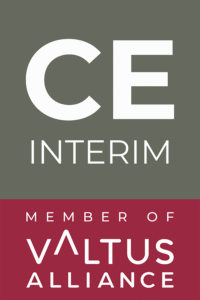Nemáte dost času na přečtení celého článku? Poslechněte si shrnutí ve 2 minutách.
Efektivní řízení zásob hraje klíčovou roli v efektivitě dodavatelského řetězce, kontrole nákladů a spokojenosti zákazníků. Budoucnost řízení zásob zajišťuje, že podniky udržují správné úrovně zásob, aby uspokojily poptávku bez nadměrných zásob.
Tento článek se věnuje novým trendům, klíčovým výzvám a účinným řešením, přičemž se zabývá i úlohou interim managementu.
1. Nové trendy v řízení zásob
Integrace automatizace a umělé inteligence
Automatizace a umělá inteligence přinášejí do správy zásob revoluci, protože zjednodušují procesy a zvyšují přesnost. Automatizované systémy sledování zásob minimalizují lidské chyby, zatímco algoritmy umělé inteligence předpovídají poptávku a optimalizují stav zásob. Robotika ve skladech zvládá úkoly, jako je třídění a ukládání do regálů, čímž zvyšuje efektivitu a snižuje náklady na pracovní sílu.
Technologie Blockchain
Technologie blockchain zvyšuje přehlednost a sledovatelnost dodavatelských řetězců. Tím, že blockchain poskytuje bezpečnou a neměnnou účetní knihu transakcí, zajišťuje, že všechny zúčastněné strany mají přístup k přesným informacím v reálném čase. Tato otevřenost pomáhá omezit podvody, zlepšit odpovědnost a usnadnit efektivnější řízení zásob.
Internet věcí (IoT)
Zařízení internetu věcí mění řízení zásob tím, že umožňují sledování stavu a úrovně zásob v reálném čase. Senzory mohou sledovat pohyb zásob, detekovat změny prostředí a upozorňovat manažery na potenciální problémy. Tato data v reálném čase pomáhají udržovat optimální úroveň zásob, snižovat plýtvání a předcházet nedostatku zásob.
Udržitelné postupy
Udržitelnost se stává klíčovým tématem při řízení zásob. Společnosti zavádějí ekologicky šetrné postupy, jako je snižování množství obalového odpadu, optimalizace přepravních tras a zásobování od udržitelných dodavatelů. Tyto postupy nejen snižují dopad na životní prostředí, ale také zlepšují pověst značky a loajalitu zákazníků.
2. Klíčové výzvy v oblasti řízení zásob
Narušení dodavatelského řetězce
Globální události, jako jsou přírodní katastrofy, geopolitické napětí a pandemie, mohou narušit dodavatelské řetězce a vést k nedostatku zásob a zpožděním. Společnosti musí vypracovat pohotovostní plány a flexibilní strategie pro zmírnění těchto rizik, jako je diverzifikace dodavatelů a udržování bezpečnostních zásob.
Předpovídání poptávky
Přesné předvídání poptávky zákazníků je náročné, ale nezbytné pro optimální řízení zásob. Pokročilé techniky předvídání, jako jsou algoritmy strojového učení a prediktivní analýza, pomáhají podnikům předvídat výkyvy poptávky a podle toho upravovat stav zásob.
Přesnost inventury
Vedení přesné evidence zásob je pro efektivní provoz klíčové. Rozdíly mezi skutečnými zásobami a evidovanými zásobami mohou vést k výpadkům zásob nebo k nadbytečným zásobám. Zavedení automatizovaných systémů sledování a pravidelných auditů může zvýšit přesnost a snížit rozdíly.
Řízení nákladů
Hledání rovnováhy mezi efektivitou nákladů a dostupností zásob je neustálou výzvou. Společnosti musí hledat způsoby, jak minimalizovat náklady na skladování, omezit plýtvání a zlepšit nákupy a zároveň zajistit uspokojení poptávky zákazníků. Efektivní strategie řízení nákladů zahrnují vyjednávání lepších podmínek s dodavateli, optimalizaci množství objednávek a zlepšení efektivity skladování.
Vyvážení nákladů a úrovně služeb
Dosažení rovnováhy mezi minimalizací nákladů a udržením vysoké úrovně služeb vyžaduje strategické plánování. Společnosti se musí zaměřit na investice do zásob, které jsou v souladu s jejich cíli v oblasti úrovně služeb, a zajistit tak, aby mohly splnit očekávání zákazníků bez nadměrných výdajů.
3. Efektivní řešení pro moderní řízení zásob
Pokročilý software pro správu zásob
Moderní systémy řízení zásob nabízejí funkce, jako je sledování v reálném čase, automatické doplňování a předvídání poptávky. Tyto nástroje mají zásadní význam pro budoucnost řízení zásob a pomáhají podnikům udržovat optimální úroveň zásob, omezovat manuální chyby a rychle reagovat na změny v poptávce. Mezi špičková softwarová řešení patří například SAP, Oracle a Microsoft Dynamics.
Postupy štíhlých zásob
Postupy štíhlých zásob se zaměřují na minimalizaci plýtvání a optimalizaci stavu zásob. Techniky jako Just-In-Time (JIT) zajišťují, že materiály jsou objednávány a přijímány právě včas pro výrobu, čímž se snižují náklady na skladování a doba držení zásob.
Společné plánování, prognózování a doplňování (CPFR)
CPFR zahrnuje úzkou spolupráci s dodavateli a partnery s cílem zlepšit předvídání poptávky a plánování zásob. Sdílením dat a poznatků mohou společnosti sladit své strategie, zkrátit dodací lhůty a zvýšit spolehlivost dodavatelského řetězce. Kroky k efektivní implementaci CPFR zahrnují vytvoření jasných komunikačních kanálů, stanovení společných cílů a používání integrovaných plánovacích nástrojů.
Školení a rozvoj dovedností
Průběžné školení týmů pro správu zásob je nezbytné pro udržení aktuálnosti nejnovějších postupů a technologií. Doporučené školicí programy a certifikace, například APICS Certified in Production and Inventory Management (CPIM), mohou zlepšit dovednosti týmu a celkově zlepšit řízení zásob.
Pravidelné audity a revize
Provádění pravidelných auditů a revizí zásob pomáhá identifikovat nesrovnalosti, pochopit výkonnost zásob a provést potřebné úpravy. Pravidelné revize zajišťují, že strategie zásob zůstávají v souladu s obchodními cíli a tržními podmínkami.
4. Techniky optimalizace zásob
Just-in-Time (JIT)
Strategie JIT minimalizuje náklady na zásoby tím, že zajišťuje, aby byl materiál objednán a přijat právě včas pro výrobu. Tato metoda vyžaduje spolehlivé dodavatele a efektivní logistiku, aby se předešlo zpožděním, a často se spoléhá na pohotovou reakci dodavatelů. Sklad 3pl partner.
JIT snižuje náklady na skladování a minimalizuje plýtvání, což vede k efektivnějšímu systému zásob.
Analýza ABC
Analýza ABC rozděluje zásoby do tří kategorií: A (vysoká hodnota, nízká frekvence prodeje), B (střední hodnota, střední frekvence prodeje) a C (nízká hodnota, vysoká frekvence prodeje). Tato klasifikace pomáhá upřednostnit úsilí managementu a efektivně alokovat zdroje se zaměřením na položky s vysokou hodnotou, které významně ovlivňují ziskovost.
Ekonomické objednací množství (EOQ)
EOQ je vzorec používaný k určení optimálního objednacího množství, které minimalizuje celkové náklady na zásoby, včetně nákladů na objednání a držení. Výpočtem nákladově nejefektivnější velikosti objednávky mohou podniky snížit náklady a udržovat dostatečnou úroveň zásob.
5. Úloha technologie v řízení zásob
Software pro správu zásob
Pokročilý software pro řízení zásob nabízí sledování stavu zásob v reálném čase, předvídání poptávky a automatické doplňování. Tyto systémy zajišťují přesnost, omezují manuální chyby a poskytují přehled pro lepší rozhodování. Funkce, jako je skenování čárových kódů a označování RFID, zvyšují efektivitu a přesnost sledování.
Automatizace a umělá inteligence
Automatizace a technologie umělé inteligence mění řízení zásob. Automatizované skladovací a vyhledávací systémy (AS/RS) zefektivňují skladové operace, omezují manuální zásahy a zvyšují efektivitu. Analytické nástroje řízené umělou inteligencí poskytují cenné informace o trendech v zásobách, výkonnosti dodavatelů a podmínkách na trhu, což umožňuje rozhodování založené na datech.
6. Úloha interim managementu v řešení zásob
Úvod do interim managementu
Interim management zahrnuje zapojení zkušených odborníků do řešení okamžitých obchodních problémů. Tito dočasní manažeři poskytují odborné znalosti a vedení během přechodných nebo krizových období a zajišťují kontinuitu a stabilitu.
Prozatímní řízení při optimalizaci zásob
Prozatímní manažeři mohou pomoci řešit problémy se zásobami zavedením účinných optimalizačních strategií, zefektivněním procesů a zvýšením přesnosti. Přinášejí nový pohled na věc a specializované dovednosti, které umožňují rychlé a účinné zlepšení.
Dovednosti a odborné znalosti dočasných manažerů
Dočasní manažeři mají klíčové dovednosti, jako je strategické plánování, zlepšování procesů a řízení změn. Jejich odborné znalosti v oblasti optimalizace zásob zahrnují zavádění pokročilých technologií, zdokonalování metod prognózování a zlepšování vztahů s dodavateli. Tyto dovednosti umožňují interim manažerům přinášet významnou hodnotu a dosahovat pozitivních výsledků v oblasti řízení zásob.
7. Osvědčené postupy pro efektivní řízení zásob
Pravidelné audity a revize
Provádění pravidelných inventurních auditů a revizí pomáhá odhalit nesrovnalosti a zajistit přesnou evidenci. Tento postup umožňuje podnikům udržovat optimální úroveň zásob, snižovat plýtvání a zvyšovat celkovou efektivitu.
Spolupráce s dodavateli
Budování pevných vztahů a spolupráce s dodavateli může zkrátit dodací lhůty, snížit náklady a zvýšit spolehlivost dodavatelského řetězce. Efektivní komunikace a spolupráce s dodavateli zajistí, že strategie řízení zásob budou v souladu s možnostmi dodavatelského řetězce a požadavky trhu.
Závěr
Optimalizace zásob má zásadní význam pro snížení nákladů, zlepšení efektivity dodavatelského řetězce a zvýšení spokojenosti zákazníků. Podniky musí neustále zdokonalovat své strategie v oblasti zásob, aby si udržely konkurenceschopnost na rychle se vyvíjejícím trhu.
CE Interim poskytuje odborní interim manažeři kteří se specializují na budoucnost řízení zásob a pomáhají podnikům optimalizovat jejich strategie v oblasti zásob. S jejich podporou mohou společnosti zvýšit efektivitu a udržet si konkurenceschopnost na rychle se vyvíjejícím trhu.





